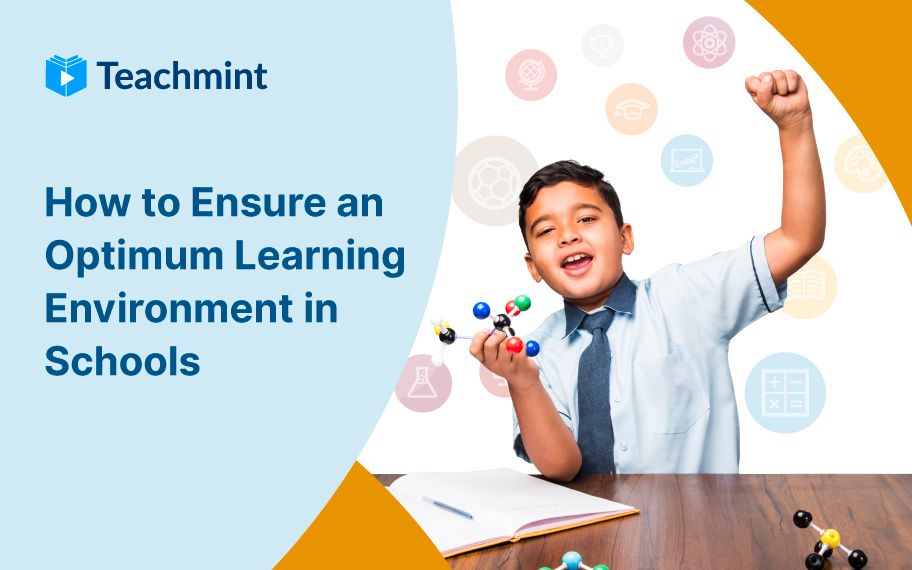An optimal learning environment makes students in a school feel safe, boosts their potential, and motivates them to face challenges without burning out.
A positive classroom environment sets up students for success. In an optimal learning environment, the learners feel respected, valued, and safe. Furthermore, such an environment invokes excitement among students. An optimal learning environment understands the needs of the students as well as the staff and supports them in multiple ways. Therefore, maintaining an optimal learning environment is a continuous process.
Need for an optimal learning environment in school:
An optimal learning environment at school benefits students in the following ways:
- It helps improve academic performance.
- Prioritizes the mental health of students.
- Motivates students to take ownership of their learning experience.
- Supports differently abled students.
- Stimulates positive interaction between students, staff, and parents.
- Creates a positive environment right from the beginning, thereby aiding student development.
How To Create an Optimum Learning Environment?
Here are some ways of creating a positive optimum learning environment for students at school:
i. Creating a positive bond with students and teachers
It is important that students and teachers know each other so they understand each others' likes, dislikes, strengths and uniqueness. Greeting students every day, when they arrive in the classroom, can be a good start. Similarly, writing notes to students on their performance will encourage them to do better.
ii. Improved engagement between students
Increasing engagement between the students helps them foster a sense of belonging that is needed to nurture a positive classroom culture. This can be done by paying attention to students' conversations to know them better. Similarly, students may feel valued if personalized lessons are conducted for them.
Additionally, positive framing of classroom rules can make a difference. For example, it may be better to say 'all students should be respected instead of 'do not disrespect any student'.
iii. Using positive reinforcement to build intrinsic motivation
It is imperative to recognize students for their efforts, even when they are unable to achieve 100% desired results. This will keep them motivated and help them address challenges. Even their smallest wins must be celebrated to cheer them up.
iv. Making content culturally relevant
Teachers must honor students' diverse cultural backgrounds and experiences by using culturally responsive teaching strategies. Every student, regardless of their age, gender, religion, and culture, must feel seen. One way of embracing diversity is to invite guest speakers from different cultural backgrounds.
v. Teachers must maintain a positive mindset
Teaching can be exhausting, for they are required to meet students' needs. Therefore, they need to take out time for self-care to maintain a positive mindset and to efficiently handle related challenges.
vi. Adding positivity to the physical environment
This can be achieved by organizing things properly, putting up positive messages on school walls, or by adding a splash of color to the classroom to encourage positive behavior.
vi. Staying updated in educational research
This ensures knowing various ways of including positivity in life. For example, research shows that parent participation positively affects a positive learning environment at school. Therefore, schools can involve parents or guardians in school activities, which will motivate students to participate.
vii. Focusing on social-emotional learning (SEL)
This helps students comprehend their emotions better and navigate through an uncertain world. SEL strategies can be implemented through mindfulness activities. When students learn to navigate their emotions, they are able to bring out their best selves. This helps them move closer to their goals.
viii. Planning lessons that interest students
Starting with topics that interest students can help spark joy in students. Teachers can gradually dive into the less interesting topics using game-based learning techniques. This leverages students' interest in games and integrates it with learning as well.
ix. Personalized feedback for students
This will help students feel valued. Personalized feedback will keep students motivated and build positive connections with their teachers. Such an exercise will underline students' efforts and help them better understand the areas that need improvement.
x. Adding a fun factor, using social media to keep in touch with parents
All work and no play can be exhausting; therefore, some fun and interactive gaming are essential to avoiding burnout. This will help students learn to work together while having fun.
Teachers can use social media to share updates of students with their parents. Alternatively, a classroom website can be used for this purpose. It is important to seek the permission of the school or guardian before using students' pictures online.
Conclusion
A positive learning environment helps students love learning and not simply do it under pressure. With the use of the right techniques and tools, such an environment makes learning adventurous. An optimum learning environment promotes a healthy environment where students know what is expected from them. Both the students and teachers feel safe and healthy in such a caring environment that fosters mutual respect, boosts potential, and keeps them enthusiastic to boldly face all challenges.
To bring ease and efficiency to the table, it is of utmost importance to digitize your school. With a brilliant suite of features, Teachmint's Integrated School Platform makes the process of management, teaching, learning, and analysis- easy, effective, and practically consolidated with one another. Check out the features here.






